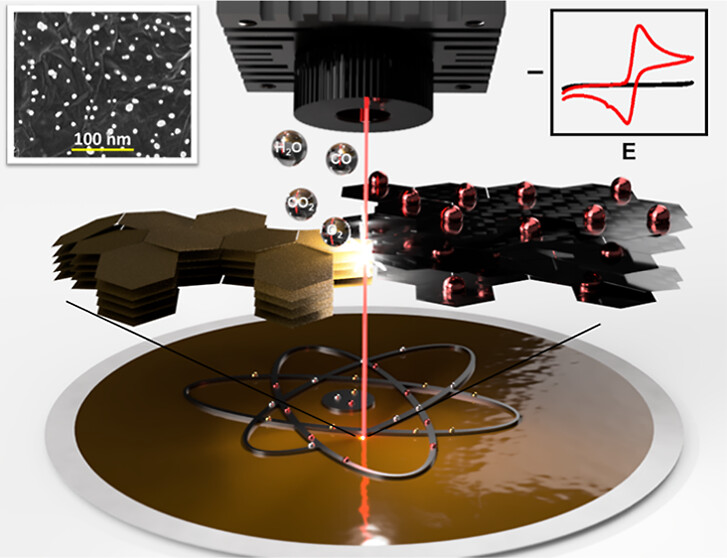Friday, 24 February 2023
Two steps in one: Novel laser-based technique simplifies the production of nanostructured films for sensing applications
A study published in ACS sensor and led by members of the ICN2 Nanobioelectronics and Biosensors Group introduces a one-step, versatile technique to produce nanocomposite films (made of reduced graphene oxide embedding metal nanoparticles) to be used as sensing substrates for different applications. The simplicity of this approach can allow scaling sensor production and reducing costs.

Nanostructured materials synthesized by combining 2D materials, such as graphene and its derivatives (i.e., graphene oxide), with metal nanoparticles have proved to exhibit peculiar and useful properties that can be exploited to develop sensors for optical, electrochemical and gas detection applications. These composite films, though, are normally produced via multi-step procedures, which involve the use of various reagents and provide limited control over the result.
A paper recently published in ACS Sensors proposes a novel strategy to fabricate in a single step a freestanding film of reduced graphene oxide (rGO) incorporating metal nanoparticles of gold, silver and platinum. In this work —led by Dr Ruslan Álvarez-Diduk and Prof. Arben Merkoçi, senior researcher and group leader respectively of the ICN2 Nanobioelectronics and Biosensors Group, and carried out in collaboration with PhD student Annalisa Scroccarello and other colleagues at the University of Teramo (Italy)— infrared-laser was used to simultaneously reduce graphene oxide and metal cations, resulting in a high exfoliated rGO substrate decorated with metal nanoparticles.
The authors of this research optimized the technique to produce the nanocomposites (Au@rGO, Ag@rGO and Pt@rGO), fully characterized them and demonstrated how they can be easily transferred onto flexible substrates to fabricate electrodes. These electrodes were then used to design and build electrochemical sensors for the detection of different analytes. In particular, they were tested for the identification of caffeic acid, nitrite, and hydrogen peroxide in model solutions and real samples. By comparing the results with those reported in literature for similar sensors based on graphene-derivate substrates (both pristine and decorated with metal nanoparticles), the researchers could demonstrate that the sensors fabricated with the proposed novel technique provide better or comparable performance.
This method allows producing freestanding nanocomposites films in a straightforward, versatile, and cost-effective way, since cumbersome procedures or inclusion of reactants are not required. In addition, precise patterning is enabled by the use of laser scribing. The success of the tested nanocomposite-based sensors in detecting target molecules demonstrates the great potential of this approach. These results open the way to faster, easier, and cheaper fabrication of high-quality functional substrates, made of reduced graphene-oxide and embedding different metal nanoparticles, which are extremely useful for a a variety of sensing applications.
An overview video of the laser-assisted fabrication process is available here.
Reference article:
Annalisa Scroccarello, Ruslan Álvarez-Diduk, Flavio Della Pelle, Cecilia de Carvalho Castro e Silva, Andrea Idili, Claudio Parolo, Dario Compagnone, and Arben Merkoçi, One-Step Laser Nanostructuration of Reduced Graphene Oxide Films Embedding Metal Nanoparticles for Sensing Applications. Sensors ACS, February 2023. DOI: 10.1021/acssensors.2c01782

